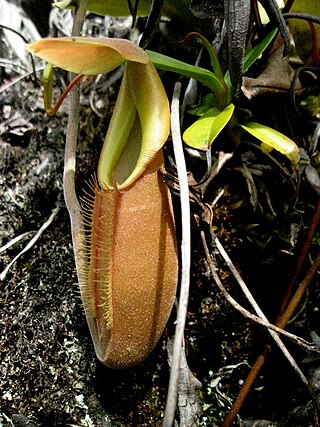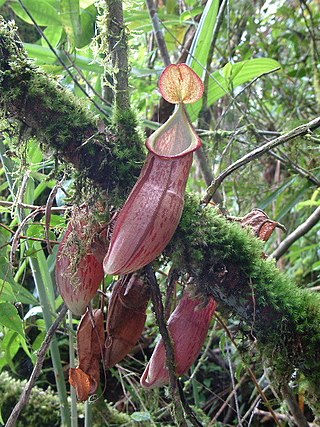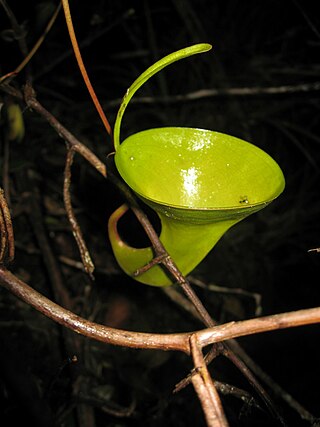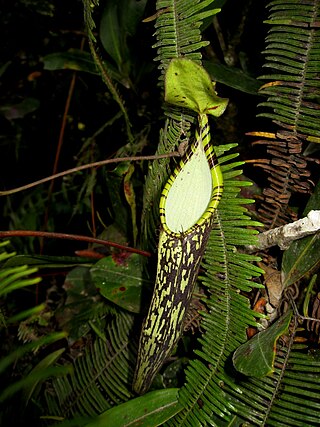
Nepenthes reinwardtiana is a tropical pitcher plant native to Borneo and Sumatra and to a number of smaller surrounding islands including Bangka, Natuna, Nias, and Siberut. Although some sources have included Peninsular Malaysia and Singapore within the range of this species, these records appear to be erroneous.

Nepenthes spathulata is a tropical pitcher plant native to Java and Sumatra, where it grows at elevations of between 1100 and 2900 m above sea level. The specific epithet spathulata is derived from the Latin word spathulatus, meaning "spatula shaped", and refers to the shape of the lamina.

Nepenthes angasanensis is a tropical pitcher plant species endemic to Sumatra, where it grows at an altitude of 1,400 metres (4,600 ft) to 3,100 metres (10,200 ft) above sea level. The status of this taxon is controversial as it is similar in morphology to N. mikei and N. tobaica. It has even been suggested that the taxon might represent a natural hybrid between N. densiflora and N. tobaica.

Nepenthes bongso is a tropical pitcher plant endemic to Sumatra, where it has an altitudinal distribution of 1000–2700 m above sea level. The specific epithet bongso refers to the Indonesian legend of Putri Bungsu, the spirit guardian of Mount Marapi.

Nepenthes gymnamphora is a tropical pitcher plant native to the Indonesian islands of Java and Sumatra. It has a wide altitudinal range of 600–2,800 metres (2,000–9,200 ft) above sea level. There is much debate surrounding the taxonomic status of this species and the taxa N. pectinata and N. xiphioides.

Nepenthes eustachya is a tropical pitcher plant endemic to Sumatra, where it grows from sea level to an elevation of 1600 m. The specific epithet eustachya, formed from the Greek words eu (true) and stachys (spike), refers to the racemose structure of the inflorescence.

Nepenthes sumatrana is a tropical pitcher plant endemic to the Indonesian island of Sumatra, after which it is named.

Nepenthes tobaica is a tropical pitcher plant endemic to Sumatra. It is particularly abundant around Lake Toba, after which it is named.

Nepenthes singalana is a tropical pitcher plant endemic to the island of Sumatra, where it grows at 2000–2900 m above sea level. It is most closely allied to N. diatas and N. spathulata.

Nepenthes densiflora is a tropical pitcher plant endemic to Sumatra, where it grows at an altitude of between 1700 and 3200 m above sea level.

Nepenthes inermis is a tropical pitcher plant endemic to the Indonesian island of Sumatra. The specific epithet inermis is Latin for "unarmed" and refers to the upper pitchers of this species, which are unique in that they completely lack a peristome.

Nepenthes ovata is a tropical pitcher plant endemic to Sumatra. The specific epithet ovata is Latin for "ovate" and refers to the shape of the lower pitchers.

Nepenthes spectabilis is a tropical pitcher plant endemic to Sumatra, where it grows at elevations of between 1400 and 2200 m above sea level. The specific epithet spectabilis is Latin for "visible" or "notable".
Nepenthes lavicola is a tropical pitcher plant species endemic to the Geureudong Massif of Aceh, northern Sumatra, where it grows at 2000–2600 m above sea level. It is thought to be most closely related to N. singalana and N. spectabilis.

Nepenthes junghuhnii is a tropical pitcher plant native to Sumatra. This species has been the source of much confusion since its discovery. The taxon originally named N. junghuhnii by John Muirhead Macfarlane has never been formally published. In 1994, taxonomist Jan Schlauer described N. junghuhnii as a "rather dubious species based on insufficient specimens". Nepenthes junghuhniisensu Macfarlane has not been relocated in the wild since the collection of the type specimen. It is characterised by strongly petiolate leaves and appears to be most closely related to N. bongso and N. spathulata; Schlauer considers it a possible synonym of the former.

Nepenthes × trichocarpa, the dainty pitcher-Plant, is a common natural hybrid involving N. ampullaria and N. gracilis. It was originally thought to be a distinct species and was described as such.

Nepenthes × pyriformis is a natural hybrid involving N. inermis and N. talangensis. It is known only from Mount Talang in Sumatra, to which N. talangensis is endemic. Nepenthes talangensis was only described as a distinct species in 1994. Prior to this it was placed within N. bongso and some of the older literature identifies this hybrid as N. bongso × N. inermis.
Mount Pangulubao or Pangulubau is a mountain near Lake Toba in Sumatra.

Nepenthes of Sumatra and Peninsular Malaysia is a monograph by Charles Clarke on the tropical pitcher plants of Sumatra, Peninsular Malaysia, and their minor surrounding islands. It was published in 2001 by Natural History Publications (Borneo). Clarke described it as "intermediate between an ecological monograph and a taxonomic one".
















